

Top Revolutionary Technologies in Healthcare. In today's world, technology plays an important role in every industry as well as in our personal lives.
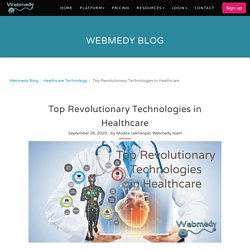
Out of all of the industries that technology plays a crucial role in, healthcare is definitely one of the most important. This merger is responsible for improving and saving countless lives all around the world. The present healthcare system is essentially a sick-care system, built in the middle of the last century. Although there's been tremendous progress on medical diagnosis and treatments, care delivery hasn't structurally changed much. Here we start a future with technologies where patients and doctors are fully connected.
Virtual reality (VR) is changing the lives of patients and physicians alike. ARTIFICIAL INTELLIGENCE (AI) is being adopted in diagnostics, EHR analytics, synthesizing information from a range of sources (scientific papers, journals, and patient medical records), and remote monitoring of patients using wearable devices. Social Benefits of EHR. How does EHR reduce Operating Costs? Healthcare providers have two options when picking an electronic health record (EHR) system - the first one is to pick a client-server EHR, and the second one is to have an EHR system where the software is hosted by the vendor in the cloud.
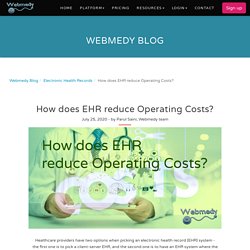
Well, both of these systems have numerous, insurmountable benefits over paper records. Cloud-based EHR systems are superior as they offer significantly more advantages to small practices over the client-server model. Healthcare professionals have found that Cloud EHR technology has the potential to reduce operational costs. Top 5 Trends in Healthcare. Healthcare stimulates its IT journeyTechnology usage is picking up in healthcare, with AI, telehealth, cloud, and smart home technologies making the next wave of innovation.
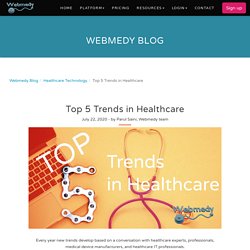
With a shortage of physicians and nursing staff and a rapidly aging baby boomer population is generating demand for telehealth options and in-home health tech.Technology is slated to act more of a helping role, not a replacement role, in healthcare delivery. With the use of AI solutions, healthcare experts will see improved performances in their workflow. Any tools that doctors can utilize to ease staffing shortages, decrease cognitive overload, and better optimize workflows will be important to doctors.Rising Stress - Data Accessibility vs Data ProtectionHealthcare wearables, smart home technologies, and even at-home tests are generating huge piles of data to be synthesized, and everyone needs to access that data. Five ways Physicians can grow their practice online. Optimized WebsiteOne of the most important parts of any healthcare marketing strategy is your website, which reflects your brand or business.
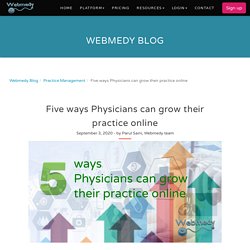
If your website is not updated, professional, and polished looking, your prospective patients might doubt the authority of your practice. Your practice's website should have a description of your practice and the services you offer, staff information, and your patient's testimonials. Once you have a practice's website, optimize it for more visibility. There are billions of websites online today. Make sure you have a solid SEARCH ENGINE OPTIMIZATION (SEO) strategy to make your website visible to your target patients. What is National Patient Identifier and how it can solve patient misidentification? Patient misidentification has remained a hot button problem for over two decades and the National Patient Identifier could be the solution.
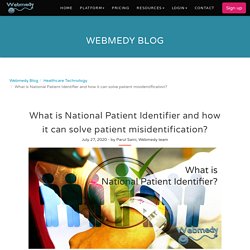
Are you wondering what a National Patient Identifier is? Then have a look at the section below here is, in brief, what are National Patient Identifiers and their importance in healthcare. The Biggest Problem - Patient Misidentification. Growth of telemedicine in healthcare. Telemedicine is the fastest growing sector in healthcare.
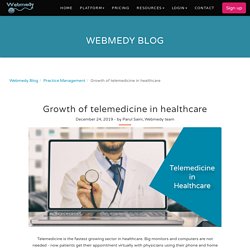
Big monitors and computers are not needed - now patients get their appointment virtually with physicians using their phone and home computers. According to the survey of the Deloitte Center for Health Solutions 2013, 18% of primary healthcare physicians use telemedicine for visits and consultations and is integrated with their practice management. Telemedicine is an important key to improve access to health and care outcomes. In May 2013, New England Journal of Medicine noted that doctors in many healthcare settings are adopting telemedicine as an approach to reach out to new patients and grow their practice and possibly to advance the patient's care who historically had bad access to medical facilities. Factors affecting the adoption of EHR. Enhancing the quality of life is one of the main goals of combining innovations into medicine.
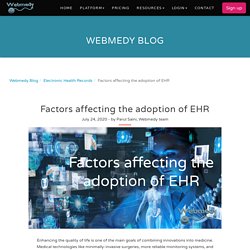
Medical technologies like minimally-invasive surgeries, more reliable monitoring systems, and more convenient scanning equipment are enabling patients to spend less time in healing and more time experiencing a healthy life. It is true that with increasing digitalization, EHR has been a booming trend in healthcare, and gradually it is being adopted all across the globe in hospitals and clinics. The following are some of the factors affecting the adoption of EHR. Internal Factors Influencing EHR Adoption One aspect of adopting EHRs by physicians in small practices is the initial investment and continuous operational costs. How physicians are using EHR for COVID-19 treatment. Rising use of EHR TelehealthDuring this time of COVID-19, telehealth usage has skyrocketed due to the increased burden on hospitals and the enormous need for social distancing to help curb the spread of the virus.
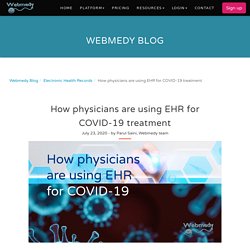
In a survey study conducted by Sykes Enterprises, about three-quarters of the respondents said that they would use telehealth treatment if they encounter coronavirus symptoms. Of the 20% who have tried telehealth, almost 60% have used it more than once and almost 37% stated they would try it again. According to the 2019 survey by J.D. Power, telehealth has a tremendous satisfaction rate than other healthcare choices.The pandemic has caused healthcare organizations to concentrate on the hurdles that come from the coronavirus, such as capacity planning for Medical Staff, Personal Protective Equipment (PPE), and ICU beds.
Top 5 Trends in Healthcare. How COVID-19 is accelerating the adoption of AI in healthcare. The COVID-19 pandemic has caused profound shifts within both the healthcare system and the world at large.
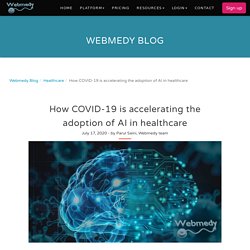
The continuous and dynamic nature of this public health emergency is showing the value of having ways and solutions that are adaptable rather than fixed. Under the telemedicine and digital health umbrella, artificial intelligence, and machine learning are increasingly used and combined to analyze the data and give actionable insights to improve healthcare. Doctors have moved towards the use of digital devices, but Covid-19 is accelerating that shift. What is Remote Patient Monitoring and its Impact on Healthcare? Remote patient monitoring (RPM) is a promising field that has the potential to improve clinical outcomes and reduce chronic care costs.
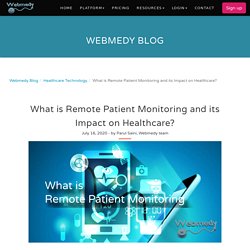
At present, about 88% of hospitals are spending or thinking to invest in remote patient monitoring. 68% of healthcare organizations fully wish to use remote patient monitoring solutions to support providers maintain the health of high-risk patients, according to the Consumer Technology Association (CTA). Keep on reading to know how remote patient monitoring works and what are the future trends for remote patient monitoring. Why Governments need to spend more on Healthcare Infrastructure?
Are Governments around the globe spending enough on healthcare infrastructure? Global pandemics like COVID-19 have brought to the forefront the need for governments to spend substantially on building healthcare infrastructure. Healthcare is a basic Responsibility of Government While it is vitally important to defend the country against border nations against hostile aggression and hence the need to spend suitably on defense, it is vitally important to be able to defend the nation's population against internal health outbreaks and pandemics.
Unfortunately, spending on healthcare compared to other areas like defense and business etc is astonishingly very low for most of the countries. How WHO is fighting the Coronavirus Pandemic. Helping the countries to prepare and respondWHO has announced a COVID-19 Strategic Preparedness and Response Plan, that identifies the major actions nations need to take and support required to carry them out. The updated plan as recent information and data improve WHO's understanding of the nature of the virus and how to respond, serves as a guide for developing country-specific plans. The six local offices and 150 country offices of WHO, work closely with governments around the globe to prepare their Health systems.With partners, WHO has set up a COVID-19 Solidarity Response Fund, to make sure that patients receive the care they need, and frontline workers get the necessary equipment and information; and to stimulate research and development of a vaccine and treatments for all who require them.
How is Machine Learning being used in treatment of rare diseases? The arrival of machine learning (ML) and its associated abilities have created numerous possibilities for intelligent intervention, which, if leveraged perfectly, can significantly help in treating rare diseases. Want to know how? Keep reading. Rare Disease Facts There are over 300 million people living with one or more of over 6,000 identified rare diseases around the world.Each rare disease may only affect a small number of people, scattered around the world, but taken together is substantial and equivalent to the population of the world's third-largest country.Rare diseases currently affect 3.5% - 5.9% of the worldwide population.72% of rare diseases are genetic whilst others are the result of infections (bacterial or viral), allergies and environmental causes, or are degenerative and proliferative.70% of those genetic rare diseases start in childhood.
What is Fast Healthcare Interoperability Resources (FHIR) and its benefits? How is Machine Learning being used in treatment of rare diseases? What are the benefits of a Patient Portal for your practice and patients? What are the Regulations on EHR in India? The Information Technology Act 2000, Data Privacy Rules and Regulations in India describes the tasks and duties clearly. These are very comparable to International Legislation, be it the Data Protection Law such as the GDPR in UK/EU or HIPPA in North America. While exposing the National Health Portal, The Government of India has come forward with rules for Electronic health record standards in India.
The document suggests a set of criteria to be followed by different healthcare service providers in India so that medical data becomes transferable. India is setting up a National eHealth Authority (NeHA) for standardization, storage, and transfer of electronic health records of patients as a component of the government's Digital India program.
The goal is to guarantee security, confidentiality, and privacy of patient data. Why is EHR Interoperability Important. In healthcare IT, it's really difficult to think of any huge buzzword other than interoperability. Interoperability influences healthcare quality for both - patients and physicians. The major purpose of healthcare interoperability is to enable the flow of health data seamlessly between care-provider and other healthcare systems participating in the care delivery of the patient for better decision making. Do you know what interoperability implies in healthcare? Interoperability is the capability of medical devices and technologies to share, explain and showcase health data in an easily digestible form whenever and wherever a patient receives care.
Healthcare systems should be able to carefully and actively create and brings meaningful clinical knowledge, decisions, and actions. Typically, there are seven different levels of interoperability. Level 0 or we can say NO InteroperabilityStand-alone systems which don't have interoperability. Advantages of Blockchain Technology for EHR. What is Fast Healthcare Interoperability Resources (FHIR) and its benefits? Social Benefits of EHR. How can Augmented Reality help Healthcare? Augmented Reality (AR) is one of the newest innovations gaining popularity and use in various markets such as gaming, automotive, retail, and many more. Augmented reality is now making its impact in the Healthcare industry as well.
Augmented reality is one of the most growing digital health technologies today. Why Governments need to spend more on Healthcare Infrastructure? EHR - Electronic Health Record. How WHO is fighting the Coronavirus Pandemic. Top Fatal Diseases Ever. (430 to 426 BCE) Plague of AthensDuring the Peloponnesian War, typhoid fever hit a quarter of the Athenian troops and a quarter of the population. The definite cause of the plague was undiscovered for many years. Researchers from the University of Athens in 2006 January, examined teeth recovered from a mass grave beneath the city and verified the presence of bacteria accountable for typhoid.(541 to 750 AD) Plague of JustinianThe first reported outbreak of bubonic plague began in Egypt and entered Constantinople the next spring, killing 10,000 a day at its top, and perhaps 40% of the city's residents.
What is Meaningful Use of EHR? The U.S. administration originated the Meaningful Use plan as a component of the 2009 Health Information Technology for Economic and Clinical Health (HITECH) Act, to support health care providers to prove "meaningful use" of certified Electronic Health Record (EHR). In performing so, qualified providers who do so get incentive payments. How does the Human Immune System work? Our immune system is necessary for our endurance. Without an immune system, our bodies would be exposed to hit from bacteria, viruses, parasites, and more. How Social Distancing can help Control COVID-19? Staying home can help stem the coronavirus outbreak, but what if you're well?
Is it a good idea to go for a run in a congested park, go to the store, or visit your friends? With the number of COVID-19 cases rising every day, doctors offer insights on how to isolate yourself from others, while still arranging the social help you need. Throughout the world, government officials are suggesting people who have contracted or been exposed to the new coronavirus to follow social distancing and quarantine to slow virus spread. Social distancing means maintaining a safe distance (about 6 feet) from others and avoiding crowded places such as parties, offices, concert halls and city transportation.Quarantine means avoiding contact with others if a person has been exposed to COVID-19 to observe if they become ill.Isolation means isolating a person who has got COVID-19 to stop them from spreading it to others.
Advantages of Integrating Electronic Lab Ordering with EHR. One of the notable difficulties faced by doctors today is giving managing Lab Orders electronically. How appointment intake forms can streamline your practice's EHR workflow? Interoperability with Google Cloud Healthcare API. Cloud Healthcare API links the gap between healthcare systems and applications developed on Google Cloud.
Cloud Healthcare API combines your information to excellent Google Cloud abilities, involving continue data flow by Cloud Dataflow, expandable analytics by BigQuery, and machine learning by Cloud Machine Learning Engine. EHR on Apple iOS. People on average visit a care provider about 300 times during their lives. The Role of NLP In Healthcare.
Telemedicine during COVID-19. How does EHR increase productivity? What is Coronavirus and what you need to know about it. Why is EHR Interoperability Important. Why EHR is Important. New Technological Advancements in Surgery. Top Technologies that will Transform Healthcare in 2020. Top Technologies that will Transform Healthcare in 2020. Use of Biometrics in PHR(Personal Health Record) Quality Care and Patient Satisfaction. How does EHR improve Quality of Care? Adoption of EHR in India. Advantages of EHR for rural health care organizations. Artificial Intelligence - Changing the way we diagnose cancer. Challenges in Adoption of EHR. The new era of mHealth. How AI will impact healthcare. Top benefits of Internet of Things (IoT) in healthcare.
Security controls needed for a secure EHR application. Top reasons why cloud based EHR platforms are gaining traction. How technology can address the patient no-show problem. What is FHIR and its benefits and challenges? Benefits of patients access to their own EHR data. What do you understand by Clinical Decision Support System? How social media can help your practice to generate more clients? Who owns patient's data? Top 4 healthcare technology trends that will impact 2019.
What is HIPAA for Healthcare? What is Wearable Technology and its use in Healthcare. How EMR usage can make a difference in medication non-adherence? How EHR impact a physician's productivity? Growth of telemedicine in healthcare. Difference between EHR and EMR. Role of Testing to Tackle COVID-19 Epidemic. Benefits of Patient Portal for Patient Engagement. EHR - Electronic Health Record.
Best Practice Management Software. EHR - Electronic Health Record. How can a Patient Portal benefit Healthcare Organizations? How EHR impact a physician's productivity?